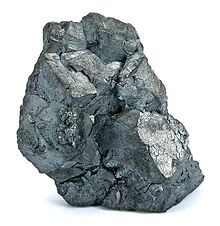Argyrodite
| Argyrodite | |
|---|---|
 | |
| General | |
| Category | Sulfide mineral |
| Formula (repeating unit) | Ag8GeS6 |
| IMA symbol | Agy[1] |
| Strunz classification | 2.BA.35 |
| Crystal system | Orthorhombic |
| Crystal class | Pyramidal (mm2) H-M symbol: (mm2) |
| Space group | Pna21 |
| Unit cell | a = 15.149, b = 7.476 c = 10.589 [Å]; Z = 4 |
| Identification | |
| Color | Black, purplish tinge |
| Crystal habit | Pseudo-octahedra or pseudo-cubic, dodecahedra, cubes; radiating crystal aggregates, botryoidal crusts, or massive |
| Twinning | Pseudospinel law {111} penetration twins |
| Cleavage | Absent |
| Fracture | Uneven to conchoidal |
| Mohs scale hardness | 2.5 |
| Luster | Metallic |
| Diaphaneity | Opaque |
| Specific gravity | 6.2-6.5 |
| Optical properties | Weakly anisotropic |
| Pleochroism | Weak |
| References | [2][3] |
Argyrodite is an uncommon silver germanium sulfide mineral with formula Ag8GeS6. The color is iron-black with a purplish tinge, and the luster metallic.
Discovered by Clemens Winkler in 1886,[4] it is of interest as it was described shortly after the element germanium was isolated, 15 years after it had been postulated by Mendeleev. It was first described for an occurrence in the Himmelsfürst Mine, Erzgebirge, Freiberg, Saxony, Germany.[3]
The Freiberg mineral had previously been imperfectly described by August Breithaupt under the name "Plusinglanz", and Bolivian crystals were incorrectly described in 1849 as crystallized .[4]
Isomorphous with argyrodite is the corresponding tin bearing mineral Ag8SnS6, also found in Bolivia as pseudocubic crystals, and known by the name canfieldite.[4] There is also a related mineral, , with composition (Cu4.7Ag3.3)GeS6.
Argyrodite gets its name from the Greek words that loosely translate into "rich in silver".[2]
Argyrodite-type material[]
The term argyrodite is also used for other materials with a similar crystal structure, in particular lithium based argyrodite-type materials, which have received interest from researchers as a potential solid-state electrolyte for lithium-ion batteries.[5][6]
They are considered to be of the form:
Li
7-xBCh
6-xX
x
With x between 0 and 1, B denoting either phosphor or arsenic, Ch for sulfur or selenium and X for chlorine, bromine or iodine.[5]
References[]
- ^ Warr, L.N. (2021). "IMA–CNMNC approved mineral symbols". Mineralogical Magazine. 85: 291–320.
- ^ a b Handbook of Mineralogy
- ^ a b Mindat.org
- ^ a b c Spencer 1911, p. 488.
- ^ a b Raghavan, Prasanth; Fatima, Jabeen (2021-04-05). Ceramic and Specialty Electrolytes for Energy Storage Devices. CRC Press. ISBN 978-1-000-35180-4.
- ^ Brinek, Marina; Hiebl, Caroline; Wilkening, H. Martin R. (2020-06-09). "Understanding the Origin of Enhanced Li-Ion Transport in Nanocrystalline Argyrodite-Type Li6PS5I". Chemistry of Materials. 32 (11): 4754–4766. doi:10.1021/acs.chemmater.0c01367. ISSN 0897-4756. PMC 7304077. PMID 32565618.
Attribution:
- This article incorporates text from a publication now in the public domain: Spencer, Leonard James (1911). "Argyrodite". In Chisholm, Hugh (ed.). Encyclopædia Britannica. Vol. 2 (11th ed.). Cambridge University Press. p. 488.
- Silver minerals
- Sulfide minerals
- Germanium minerals
- Orthorhombic minerals
- Minerals in space group 33
- Sulfide mineral stubs